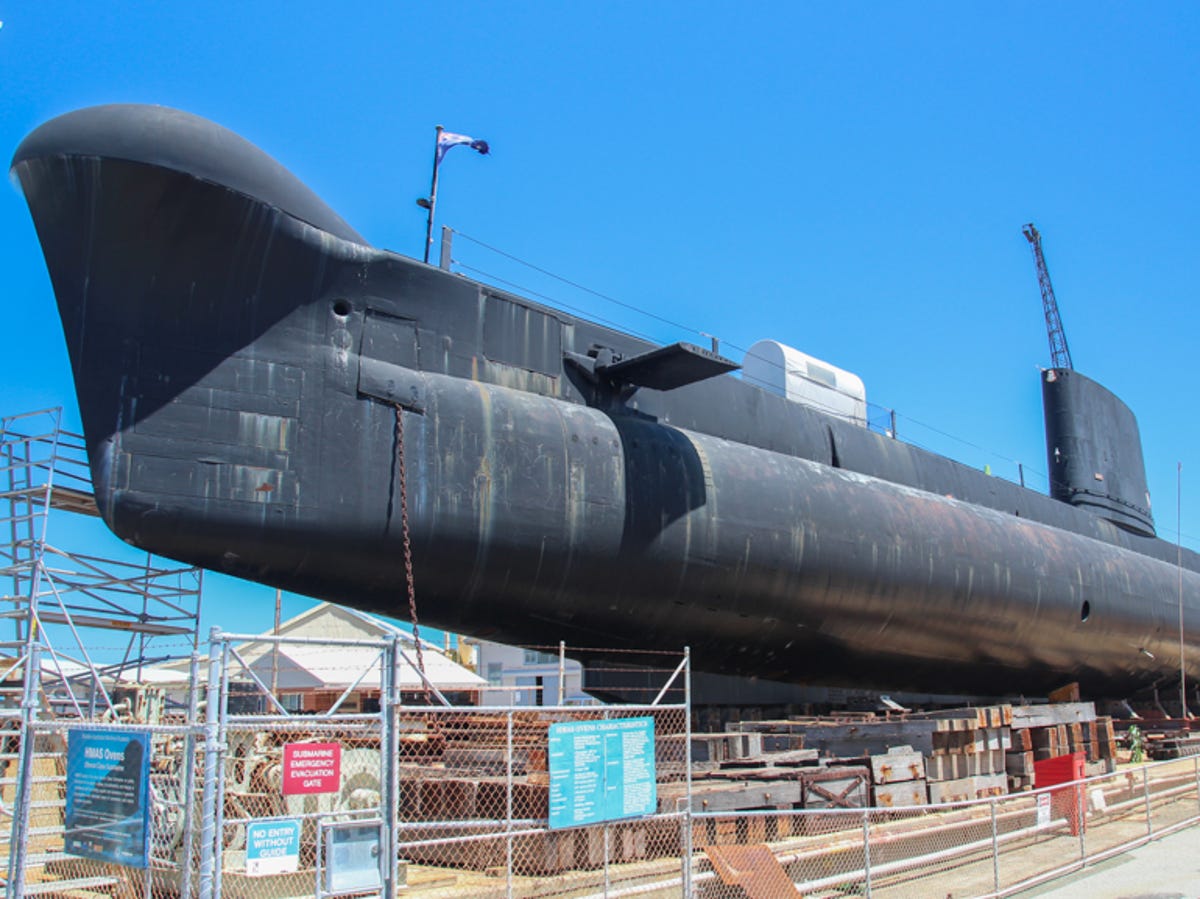
Ovens
The HMAS Ovens, a museum ship dry-docked in Fremantle, Western Australia, served in the Royal Australian Navy for 26 years.
The diesel-powered ship was not named after a gas range. Rather, it honors Irishman and Australian explorer John Ovens (1788-1825).
For the full story behind the tour, check out "Hot sub time machine: A photo tour of the HMAS Ovens submarine."
Batteries included
Before you head out to the ship, in the museum itself is one of the 448 battery cells. Each is 2 volts, run in series in two batteries, for a total of 440 volts.
Frontispiece
As you walk out to the ship, on display is a nose cone from an Oberon-class boat. The torpedo with the orange stripes is a WWII-era diesel-powered torpedo.
Tight fit
Quite a tight fit, though I guess that makes sense. Up top, sonar array.
Ears
On the walk to the sub is a hydrophone, the "ears" of the sub. Never knew what these looked like before.
Bow
Three torpedo tubes on each side. Originally there were two more in the stern, but as you'll see, they're gone.
Props
No fancy pump jets for this sub, just two old-fashioned screws, driven by electric motors (and electricity from two V16 diesel generators).
Torpedoes and missiles
Originally the Ovens was just equipped with torpedoes, but eventually it was able to fire Harpoon missiles, horizontally, from the torpedo tubes. They'd head to the surface, light their booster rockets and scream through the air toward their target.
On deck
You enter the Ovens by going up a few flights of stairs, and climbing down through the torpedo loading tube. This is surprisingly common, since the original way of entering the sub involved enlistment (kidding; a ladder).
Flags
Silence IS golden. Note the Jolly Roger.
Safety first
The railing is for the safety of sailors so they wouldn't slip off into the sea (from which there's no easy way back up again).
Below the surface
Down you go! This is the view back up the entrance. It's a fairly tight fit.
Three up and three down
Here you can see all six torpedo tubes. The orange suit is used in an emergency evacuation. The silver tube at the top of the picture (with the two lines of red tape) is the escape trunk.
Bunks and bunks and a dining room
The next room down is the main crew bunks. Each main crew member gets his own bunk. This is also where the crew ate their meals.
Main entrance
The main entrance. Rather nondescript, isn't it?
Hatches
Really nondescript. Also, shut.
Mess
The senior sailors' mess. The higher-ranking officers got this spacious playground. The mannequins, as you'll see, are a little…odd.
Multimedia
Check out that big-screen TV! And cassettes! Love it.
Food
The galley. According to tour guide, former CPO Coombs, Navy food was good, and submarine food was even better.
Multiuse
The chief engineer's cabin…and also the sick bay.
Wardroom
The wardroom was for the officers. Check out that laptop. One of my favorite things about tours like this is when they leave era-appropriate technology around as sort of mise-en-scène.
Bridge
Here are the two main fire control terminals. The six rows of six buttons are for each torpedo tube. The happy gent on the right is the sonar operator.
Sonar (and my arm)
Sorry for the picture quality, it was a bit dark. You can also see my arm! GoPros are really wide-angle. So yeah, this is the sonar station.
Sail?
In the middle of the bridge is access to the conning tower. I've never actually been up in one of these. I'd like to. Anyone know where? In the lockers are a .50 cal machine gun and various sidearms and ammo.
Dials and knobs
Dials, knobs and tubes. Miles and miles of tubes. Every sailor on the sub would have to know what every knob and dial did and showed.
Driving Mrs. Ovens
Not sure if there’s a clutch. The box to the right is the autopilot/inertial navigation.
Head
Just off the bridge are several toilets, or heads. The space in the middle of the image is one of the showers. "Once a week, whether you need it or not."
V16 power
The huge 16-cylinder engines didn't actually drive the props, at least not directly. Instead, they generated electricity to recharge the batteries and power the electric motors.
Engine room
Dials for every aspect of the sub's drivetrain and power.
Bunks front to back
The crew at the back of the ship generally stayed at the back of the ship, and the crew at the front stayed in the front. That’s because subs are very carefully balanced fore and aft.
Rear dining room
Engineers slept and ate back here. Note the small rectangular hole in the center-right of the image. Movies were projected through this hole into the next room.
High-tech
LaserDisc! Like I said, I love the era-specific tech and signage.
Rear 'torpedo' room
The aftmost space on the ship; once there were two torpedo tubes here, but they were removed. This room has had much renovation; it used to have bunks and extensive emergency escape gear.
Museum
The Ovens, like all museum ships, looks slightly out of place out of the water, but there’s a certain stately majesty to it.
WA Maritime Museum
The Western Australia Maritime Museum and the HMAS Ovens are well worth a visit if you’re in the Perth area. A bit of a hike for most of you, I imagine…
Check out the full story behind the tour at "Hot sub time machine: A photo tour of the HMAS Ovens submarine."

